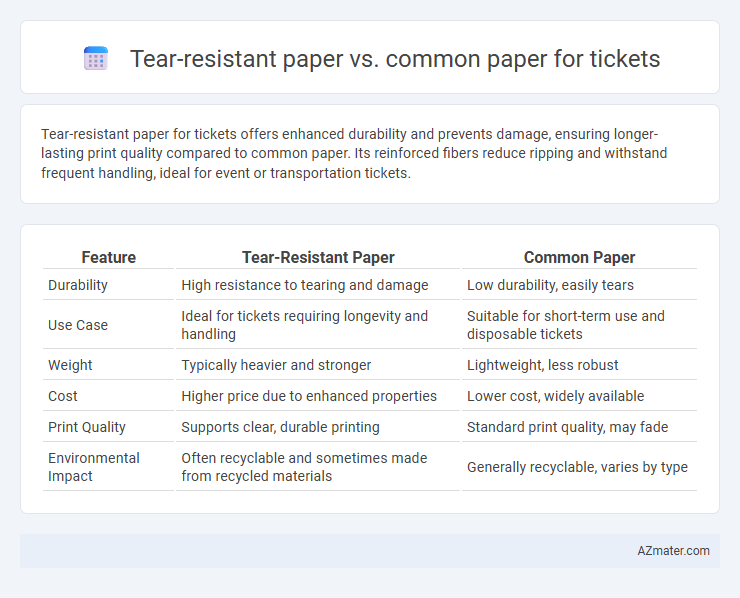Tear-resistant paper for tickets offers enhanced durability and prevents damage, ensuring longer-lasting print quality compared to common paper. Its reinforced fibers reduce ripping and withstand frequent handling, ideal for event or transportation tickets.
Table of Comparison
| Feature | Tear-Resistant Paper | Common Paper |
|---|---|---|
| Durability | High resistance to tearing and damage | Low durability, easily tears |
| Use Case | Ideal for tickets requiring longevity and handling | Suitable for short-term use and disposable tickets |
| Weight | Typically heavier and stronger | Lightweight, less robust |
| Cost | Higher price due to enhanced properties | Lower cost, widely available |
| Print Quality | Supports clear, durable printing | Standard print quality, may fade |
| Environmental Impact | Often recyclable and sometimes made from recycled materials | Generally recyclable, varies by type |
Introduction to Tear-Resistant Paper and Common Paper
Tear-resistant paper is specially engineered with synthetic fibers and reinforced materials to provide greater durability and resistance to ripping, making it ideal for high-traffic ticketing applications where longevity is crucial. Common paper, typically made from wood pulp, lacks these reinforcing components and is more susceptible to tearing and wear under frequent handling. The enhanced strength and reliability of tear-resistant paper improve ticket lifespan and reduce replacement costs compared to conventional paper options.
Key Differences in Material Composition
Tear-resistant paper for tickets is manufactured using synthetic fibers or reinforced cellulose, providing enhanced durability and resistance to tearing compared to common paper composed primarily of wood pulp fibers. The material composition of tear-resistant paper includes additives such as polyester or polypropylene, which improve tensile strength and longevity under physical stress. In contrast, common paper lacks these reinforcements, making it more prone to damage and less suitable for high-use ticketing applications.
Durability and Strength Comparison
Tear-resistant paper exhibits significantly higher durability and strength compared to common paper, making it ideal for tickets that endure frequent handling. Its fibrous composition and reinforced structure prevent easy tearing and withstand mechanical stress, ensuring ticket longevity. Common paper, by contrast, tends to rip quickly under strain, reducing its suitability for situations requiring robust, long-lasting ticket materials.
Print Quality and Visual Appeal
Tear-resistant paper offers superior print quality with sharper, more vibrant images and text, ensuring legibility and professional appearance for tickets. Its durable surface prevents smudging and fading, maintaining visual appeal even under frequent handling or exposure to moisture. Common paper often displays lower print fidelity and deteriorates quickly, leading to blurred prints and an unprofessional look.
Cost Analysis: Tear-Resistant vs Common Paper
Tear-resistant paper, designed for enhanced durability and longevity, typically incurs a higher upfront cost compared to common paper used for tickets. While initial expenses for tear-resistant paper are greater, its resistance to damage reduces replacement frequency and waste, potentially lowering long-term operational costs. Common paper, although cheaper initially, may lead to increased costs due to frequent reprints and lost ticket issues in high-traffic environments.
Environmental Impact and Recyclability
Tear-resistant paper used for tickets often contains synthetic fibers or coatings that can hinder the recycling process and increase environmental impact compared to common paper, which is typically more biodegradable and easier to recycle. The production of tear-resistant paper generally requires more energy and generates higher emissions due to the added materials, whereas common paper relies primarily on natural fibers with a simpler manufacturing process. Consequently, common paper tickets offer a more sustainable option with greater recyclability and lower ecological footprint in ticketing applications.
Security Features for Ticketing
Tear-resistant paper for ticketing incorporates embedded security fibers and watermarks that significantly enhance counterfeit prevention compared to common paper. Its durable material resists tampering and tearing, ensuring tickets remain intact throughout events and transit. Advanced security features such as UV-reactive elements and micro-printing are typically integrated into tear-resistant paper, making unauthorized duplication more difficult than standard ticket paper.
User Experience and Handling
Tear-resistant paper for tickets significantly enhances user experience by providing durability and reducing the risk of accidental rips during handling, ensuring tickets remain intact throughout events. Compared to common paper, it offers improved resistance to wear and creasing, facilitating smoother processing at entry points and minimizing complaints from users. This robust material supports better retention of printed information, leading to faster scanning and verification, ultimately streamlining operational workflows.
Best Use Cases for Each Paper Type
Tear-resistant paper excels in high-traffic environments such as concerts, sports events, and transportation ticketing where durability and longevity are critical to prevent damage during handling. Common paper suits low-volume or short-term uses like receipts or event tickets for single-day access where cost efficiency is more important than resilience. Choosing tear-resistant paper enhances customer satisfaction and operational reliability in scenarios requiring repeated handling or weather exposure.
Choosing the Right Paper for Tickets
Tear-resistant paper offers enhanced durability and longevity compared to common paper, making it ideal for tickets that require handling and long-term use. This type of paper resists ripping and damage, ensuring ticket integrity during events or transportation. Choosing tear-resistant paper reduces the risk of ticket loss or invalidation due to wear, improving customer satisfaction and operational efficiency.

Infographic: Tear-resistant paper vs Common paper for Ticket
 azmater.com
azmater.com